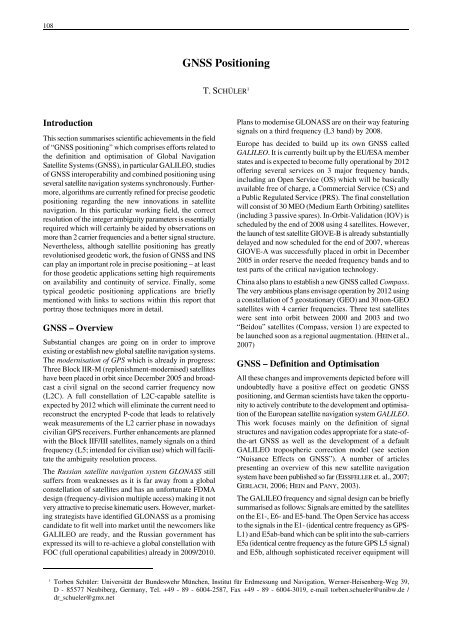NATIONAL REPORT OF THE FEDERAL REPUBLIC OF ... - IAG Office
NATIONAL REPORT OF THE FEDERAL REPUBLIC OF ... - IAG Office
NATIONAL REPORT OF THE FEDERAL REPUBLIC OF ... - IAG Office
Create successful ePaper yourself
Turn your PDF publications into a flip-book with our unique Google optimized e-Paper software.
108<br />
Introduction<br />
This section summarises scientific achievements in the field<br />
of “GNSS positioning” which comprises efforts related to<br />
the definition and optimisation of Global Navigation<br />
Satellite Systems (GNSS), in particular GALILEO, studies<br />
of GNSS interoperability and combined positioning using<br />
several satellite navigation systems synchronously. Furthermore,<br />
algorithms are currently refined for precise geodetic<br />
positioning regarding the new innovations in satellite<br />
navigation. In this particular working field, the correct<br />
resolution of the integer ambiguity parameters is essentially<br />
required which will certainly be aided by observations on<br />
more than 2 carrier frequencies and a better signal structure.<br />
Nevertheless, although satellite positioning has greatly<br />
revolutionised geodetic work, the fusion of GNSS and INS<br />
can play an important role in precise positioning – at least<br />
for those geodetic applications setting high requirements<br />
on availability and continuity of service. Finally, some<br />
typical geodetic positioning applications are briefly<br />
mentioned with links to sections within this report that<br />
portray those techniques more in detail.<br />
GNSS – Overview<br />
Substantial changes are going on in order to improve<br />
existing or establish new global satellite navigation systems.<br />
The modernisation of GPS which is already in progress:<br />
Three Block IIR-M (replenishment-modernised) satellites<br />
have been placed in orbit since December 2005 and broadcast<br />
a civil signal on the second carrier frequency now<br />
(L2C). A full constellation of L2C-capable satellite is<br />
expected by 2012 which will eliminate the current need to<br />
reconstruct the encrypted P-code that leads to relatively<br />
weak measurements of the L2 carrier phase in nowadays<br />
civilian GPS receivers. Further enhancements are planned<br />
with the Block IIF/III satellites, namely signals on a third<br />
frequency (L5; intended for civilian use) which will facilitate<br />
the ambiguity resolution process.<br />
The Russian satellite navigation system GLONASS still<br />
suffers from weaknesses as it is far away from a global<br />
constellation of satellites and has an unfortunate FDMA<br />
design (frequency-division multiple access) making it not<br />
very attractive to precise kinematic users. However, marketing<br />
strategists have identified GLONASS as a promising<br />
candidate to fit well into market until the newcomers like<br />
GALILEO are ready, and the Russian government has<br />
expressed its will to re-achieve a global constellation with<br />
FOC (full operational capabilities) already in 2009/2010.<br />
GNSS Positioning<br />
T. SCHÜLER 1<br />
Plans to modernise GLONASS are on their way featuring<br />
signals on a third frequency (L3 band) by 2008.<br />
Europe has decided to build up its own GNSS called<br />
GALILEO. It is currently built up by the EU/ESA member<br />
states and is expected to become fully operational by 2012<br />
offering several services on 3 major frequency bands,<br />
including an Open Service (OS) which will be basically<br />
available free of charge, a Commercial Service (CS) and<br />
a Public Regulated Service (PRS). The final constellation<br />
will consist of 30 MEO (Medium Earth Orbiting) satellites<br />
(including 3 passive spares). In-Orbit-Validation (IOV) is<br />
scheduled by the end of 2008 using 4 satellites. However,<br />
the launch of test satellite GIOVE-B is already substantially<br />
delayed and now scheduled for the end of 2007, whereas<br />
GIOVE-A was successfully placed in orbit in December<br />
2005 in order reserve the needed frequency bands and to<br />
test parts of the critical navigation technology.<br />
China also plans to establish a new GNSS called Compass.<br />
The very ambitious plans envisage operation by 2012 using<br />
a constellation of 5 geostationary (GEO) and 30 non-GEO<br />
satellites with 4 carrier frequencies. Three test satellites<br />
were sent into orbit between 2000 and 2003 and two<br />
“Beidou” satellites (Compass, version 1) are expected to<br />
be launched soon as a regional augmentation. (HEIN et al.,<br />
2007)<br />
GNSS – Definition and Optimisation<br />
All these changes and improvements depicted before will<br />
undoubtedly have a positive effect on geodetic GNSS<br />
positioning, and German scientists have taken the opportunity<br />
to actively contribute to the development and optimisation<br />
of the European satellite navigation system GALILEO.<br />
This work focuses mainly on the definition of signal<br />
structures and navigation codes appropriate for a state-ofthe-art<br />
GNSS as well as the development of a default<br />
GALILEO tropospheric correction model (see section<br />
“Nuisance Effects on GNSS”). A number of articles<br />
presenting an overview of this new satellite navigation<br />
system have been published so far (EISSFELLER et. al., 2007;<br />
GERLACH, 2006; HEIN and PANY, 2003).<br />
The GALILEO frequency and signal design can be briefly<br />
summarised as follows: Signals are emitted by the satellites<br />
on the E1-, E6- and E5-band. The Open Service has access<br />
to the signals in the E1- (identical centre frequency as GPS-<br />
L1) and E5ab-band which can be split into the sub-carriers<br />
E5a (identical centre frequency as the future GPS L5 signal)<br />
and E5b, although sophisticated receiver equipment will<br />
1 Torben Schüler: Universität der Bundeswehr München, Institut für Erdmessung und Navigation, Werner-Heisenberg-Weg 39,<br />
D - 85577 Neubiberg, Germany, Tel. +49 - 89 - 6004-2587, Fax +49 - 89 - 6004-3019, e-mail torben.schueler@unibw.de /<br />
dr_schueler@gmx.net











